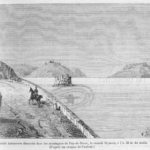The mountain hunters of past centuries have seen unaccountable and terrible forms in the mountain mists, and legends have carried the phenomena from the plainly natural to the weirdly superhuman.
– J. Gordon McPherson
The world is full of haunted places — each with its own bone-chilling claim to infamy. That said, few places can compare with the notorious Brocken of Germany’s Harz Mountains. Every Walpurgis Night — according to tradition — witches and their demonic counterparts descended upon its summit — dancing, gambolling, and laying dark plans for the future. Legends of these hijinks, which were popularised by a number of authors, had a lasting impact on Western culture. In fact, the scientific term “Brocken spectre”, which denotes a kind of atmospheric optical illusion occasionally experienced in the mountains, is directly derived from the belief that weird, luminous entities sometimes appeared on the Brocken’s windswept cliffs.
Anyone could witness these sublime but scientifically explicable “spectres”; they were not isolated to the Brocken. One interesting encounter occurred in March 1887 and involved Henri Lecoq — the nephew of the renowned naturalist of the same name. The experience left Lecoq in awe, and his account provides insight into the sort of natural wonders that could have influenced some of the mountain legends of Auvergne. The following excerpt appears in The Fairytales of Science (1891) by J. Gordon McPherson:
“In March, 1887, at half-past seven o’clock in the morning, he [Henri Lecoq] was riding up the slope of the deep ravine, at the bottom of the mountains of the puy de Dôme. The wall was almost perpendicular; the valley which he was crossing was filled with a very dense and cold mist, which covered the trees with hoar-frost. All on a sudden he escaped from the mist and found himself again in the full blue sky. The ravine was filled with the vapour, resembling the surface of a lake. He was approaching the footpath of the road, when the shadows of the horse and himself were projected on the surface of the mist. They were encircled by a luminous band presenting all the colours of the rainbow; the violet being inside and the red outside. All the colours were very vivid. The shadows were separated from the corona by a circle of yellowish hue, and the whole effect was most wonderful, reminding him of the fabled appearances of the mountain-giants.”

To receive more information on the natural wonders of Auvergne — sign up for our newsletter below!






